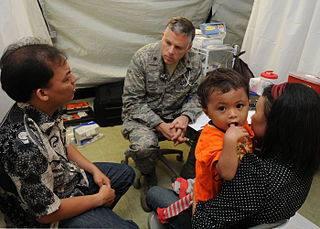Related Research Articles
Cross-cultural communication is a field of study investigating how people from differing cultural backgrounds communicate, in similar and different ways among themselves, and how they endeavor to communicate across cultures. Intercultural communication is a related field of study.
Acculturation is a process of social, psychological, and cultural change that stems from the balancing of two cultures while adapting to the prevailing culture of the society. Acculturation is a process in which an individual adopts, acquires and adjusts to a new cultural environment as a result of being placed into a new culture, or when another culture is brought to someone. Individuals of a differing culture try to incorporate themselves into the new more prevalent culture by participating in aspects of the more prevalent culture, such as their traditions, but still hold onto their original cultural values and traditions. The effects of acculturation can be seen at multiple levels in both the devotee of the prevailing culture and those who are assimilating into the culture.

Intercultural relations, sometimes called intercultural studies, is a field of social science. It is a multi-disciplinary academic field designed to train students to understand, communicate, and accomplish specific goals outside their own cultures. Intercultural relations involves, at a fundamental level, learning how to see oneself and the world through the eyes of another. It seeks to prepare students for interaction with cultures both similar to their own or very different from their own. Some aspects of intercultural relations also include, their power and cultural identity with how the relationship should be upheld with other foreign countries.

Cultural identity is a part of a person's identity, or their self-conception and self-perception, and is related to nationality, ethnicity, religion, social class, generation, locality, gender, or any kind of social group that has its own distinct culture. In this way, cultural identity is both characteristic of the individual but also of the culturally identical group of members sharing the same cultural identity or upbringing. Cultural identity is an unfixed process that is continually evolving within the discourses of social, cultural, and historical experiences. Some people undergo more cultural identity changes as opposed to others, those who change less often have a clear cultural identity. This means that they have a dynamic yet stable integration of their culture.
Interculturalism is a political movement that supports cross-cultural dialogue and challenging self-segregation tendencies within cultures. Interculturalism involves moving beyond mere passive acceptance of multiple cultures existing in a society and instead promotes dialogue and interaction between cultures. Interculturalism is often used to describe the set of relations between indigenous and western ideals, grounded in values of mutual respect.
Intercultural communication is a discipline that studies communication across different cultures and social groups, or how culture affects communication. It describes the wide range of communication processes and problems that naturally appear within an organization or social context made up of individuals from different religious, social, ethnic, and educational backgrounds. In this sense, it seeks to understand how people from different countries and cultures act, communicate, and perceive the world around them. Intercultural communication focuses on the recognition and respect of those with cultural differences. The goal is mutual adaptation between two or more distinct cultures which leads to biculturalism/multiculturalism rather than complete assimilation. It promotes the development of cultural sensitivity and allows for empathic understanding across different cultures.
Identity is the set of qualities, beliefs, personality traits, appearance, and/or expressions that characterize a person or a group.
Plurilingualism is the ability of a person who has competence in more than one language to switch between multiple languages depending on the situation for ease of communication. Plurilingualism is different from code-switching in that plurilingualism refers to the ability of an individual to use multiple languages, while code-switching is the act of using multiple languages together. Plurilinguals practice multiple languages and are able to switch between them when necessary without much difficulty. Although plurilingualism is derived from multilingualism, there is a difference between the two. Multilingualism is connected to situations wherein multiple languages exist side-by-side in a society but are utilized separately. In essence, multilingualism is the coexisting knowledge of separate languages while plurilingualism is the interconnected knowledge of multiple languages. In general, plurilinguals have had contact with languages not native to them through educational institutions, however the education system plays only a small role in the linguistic competence of these individuals. Learning a second language is thought to stimulate someone's plurilingualism.

Intercultural learning is an area of research, study and application of knowledge about different cultures, their differences and similarities. On the one hand, it includes a theoretical and academic approach. On the other hand, it comprises practical applications such as learning to negotiate with people from different cultures, living with people from different cultures, living in a different culture and the prospect of peace between different cultures.
Cultural competence, also known as intercultural competence, is a range of cognitive, affective, behavioural, and linguistic skills that lead to effective and appropriate communication with people of other cultures. Intercultural or cross-cultural education are terms used for the training to achieve cultural competence.
Tandem language learning is an approach to language acquisition that involves reciprocal language exchange between tandem partners. In this method, each learner ideally serves as a native speaker of the language the other person intends to learn. Tandem language learning deviates from traditional pedagogical practices by eliminating the teacher-student model. Numerous language schools worldwide, including those affiliated with TANDEM International, as well as several universities, incorporate this approach into their language programs.
The Bennett scale, also called the Developmental Model of Intercultural Sensitivity (DMIS), was developed by Milton Bennett. The framework describes the different ways in which people can react to cultural differences. Bennett's initial idea was for trainers to utilize the model to evaluate trainees' intercultural awareness and help them improve intercultural sensitivity, also sometimes referred to as cultural sensitivity, which is the ability of accepting and adapting to a brand new and different culture.
Multicultural education is a set of educational strategies developed to provide students with knowledge about the histories, cultures, and contributions of diverse groups. It draws on insights from multiple fields, including ethnic studies and women studies, and reinterprets content from related academic disciplines. It is a way of teaching that promotes the principles of inclusion, diversity, democracy, skill acquisition, inquiry, critical thought, multiple perspectives, and self-reflection. One study found these strategies to be effective in promoting educational achievements among immigrant students.
Cultural competency training is an instruction to achieve cultural competence and the ability to appreciate and interpret accurately other cultures. In an increasingly globalised world, training in cultural sensitivity to others' cultural identities and how to achieve cultural competence is being practised in the workplace, particularly in healthcare, schools and in other settings.

Cultural sensitivity, also referred to as cross-cultural sensitivity or cultural awareness, is the knowledge, awareness, and acceptance of other cultures and others' cultural identities. It is related to cultural competence, and is sometimes regarded as the precursor to the achievement of cultural competence, but is a more commonly used term. On the individual level, cultural sensitivity is a state of mind regarding interactions with those different from oneself. Cultural sensitivity enables travelers, workers, and others to successfully navigate interactions with a culture other than their own.
Third culture kids (TCK) or third culture individuals (TCI) are people who were raised in a culture other than their parents' or the culture of their country of nationality, and also live in a different environment during a significant part of their child development years. They typically are exposed to a greater volume and variety of cultural influences than those who grow up in one particular cultural setting. The term applies to both adults and children, as the term kid refers to the individual's formative or developmental years. However, for clarification, sometimes the term adult third culture kid (ATCK) is used.
Cultural humility is the “ability to maintain an interpersonal stance that is other-oriented in relation to aspects of cultural identity that are most important to the [person].” Cultural humility is different from other culturally-based training ideals because it focuses on self-humility rather than being an other-directed "they/them" way of achieving a state of knowledge or awareness. It is helpful to see as others see; what they themselves have determined is their personal expression of their heritage and their “personal culture”. Cultural humility was formed in the physical healthcare field and adapted for therapists, social workers, and medical librarians, to learn more about experiences and cultural identities of others and increase the quality of their interactions with clients and community members.

Cultural competence in healthcare refers to the ability for healthcare professionals to demonstrate cultural competence toward patients with diverse values, beliefs, and feelings. This process includes consideration of the individual social, cultural, and psychological needs of patients for effective cross-cultural communication with their health care providers. The goal of cultural competence in health care is to reduce health disparities and to provide optimal care to patients regardless of their race, gender, ethnic background, native languages spoken, and religious or cultural beliefs. Cultural competency training is important in health care fields where human interaction is common, including medicine, nursing, allied health, mental health, social work, pharmacy, oral health, and public health fields.
Virtual exchange is an instructional approach or practice for language learning. It broadly refers to the "notion of 'connecting' language learners in pedagogically structured interaction and collaboration" through computer-mediated communication for the purpose of improving their language skills, intercultural communicative competence, and digital literacies. Although it proliferated with the advance of the internet and Web 2.0 technologies in the 1990s, its roots can be traced to learning networks pioneered by Célestin Freinet in 1920s and, according to Dooly, even earlier in Jardine's work with collaborative writing at the University of Glasgow at the end of the 17th to the early 18th century.
The Common European Framework of Reference for Languages: Learning, Teaching, Assessment (CEFR) Companion Volume is an extension and update of the original CEFR, first published in 2001. The CEFR provides a standardized way of describing language proficiency levels. It is widely used in language education and assessment globally.
References
- 1 2 Runnels, Judith. Pluricultural Language Education and the CEFR, Preface
- ↑ pluriculturalism (2)
- ↑ Trujillo Sáez, Fernando. Culture Awareness and the development of the pluricultural competence, page 3
- 1 2 5.1. The concept of pluricultural competence, 5. PLURICULTURAL COMPETENCE: DESCRIPTIVE PRINCIPLES, coe.int
- ↑ Çelik, Servet (2013-01-25). "Plurilingualism, Pluriculturalism, and the CEFR: Are Turkey's Foreign Language Objectives Reflected in Classroom Instruction?". Procedia - Social and Behavioral Sciences. Akdeniz Language Studies Conference, May, 2012, Turkey. 70: 1872–1879. doi: 10.1016/j.sbspro.2013.01.265 . ISSN 1877-0428.
- ↑ Delgado-Algarra, Emilio José; Aguaded, Ignacio; Bernal-Bravo, César; Lorca-Marín, Antonio Alejandro (January 2020). "Citizenship and Pluriculturalism Approaches of Teachers in the Hispanic and Japanese Contexts: Higher Education Research". Sustainability. 12 (8): 3109. doi: 10.3390/su12083109 . hdl: 10272/17889 .
- ↑ "Spain's general election". The Economist . 19 December 2015. Retrieved 21 December 2015.